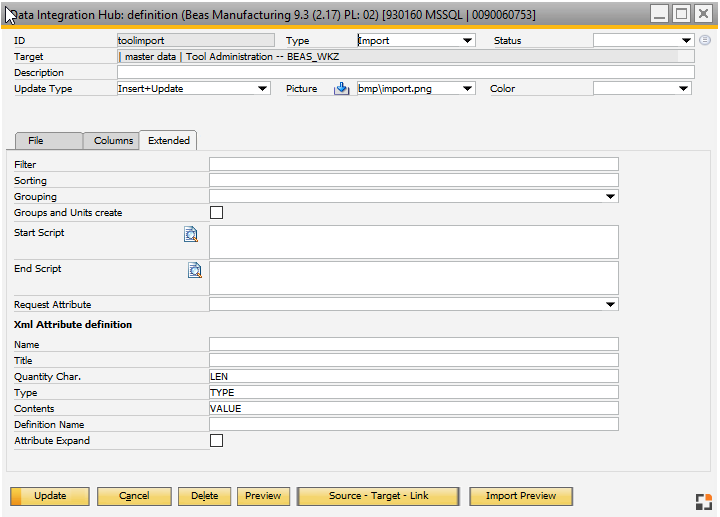|
PATH: Administration > Data Import/Export > Data Integration Hub > "Edit" Import definition.
More conditions, sorting and conversions can be defined under the extended information.

Window importkopf_edit.psr
|
|
|
Filter
|
The source table can be filtered here, that is, the entries to be imported can be limited this way.
In XML-structures, you can define which area of the stored structure is to be imported.
Example:
Import only if the item number does not begin with 1 and is not empty.
left(item,1)<>"1" and item<>""
The easiest way to define the filter is using the Preview.
|
Sorting
|
The transfer sequence can be defined here.
Example: Sorting according to source field "item" ascending: "item"
Example: Sorting according to source field "item" descending and "nr" ascending: "item desc, nr asc"
The easiest way to define the sorting is using the Preview.
|
Grouping
|
All the following rows are hidden that have the same value in this field.
Note: This only works, if you sort by this field.
Example:
Row;Item
1;A001
2;A001
3;A002
Sorted and grouped by item results:
Row;Item
1;A001
3;A002
|
|
Groups and Units create
|
This includes among others:
|
|
Start Script
|
Script is executed before the import
|
End Script
|
Script is executed after the import
|
Request attribute
|
A column can be defined, the value of which is stored in the variable
<importrequestid>.
This can be used to create a response file which is returned to a PDM-software.
From the import file the first row is determined, in which this column is present. Filters and other restrictions are not considered. Thus, the Request Id can also be located outside the import structure.
Example:
<request><requestid>1000044422</requestid></request>
<item>
<itemcode>A001</itemcode>
<description name="Assembly 001"/>
<bom>
<material>C001</material><quantity>5</quantity>
</bom>
<bom>
<material height="5" lengh="10">C002</material><quantity>5</quantity>
</bom>
</item>
In this case the Request Id would be = 1000044422
It can be further processed with <importrequestid>.
|
|
In a TAG-field attributes can be defined.
Which meaning divers tags have or in which kind these needs to be considered can be determined here.
A tag has following structure:
<tag attribut1="wert" attribut2="wert" />
<tag attribut1='wert' attribut2='wert' />
It is important to do blanks and to set quotation marks. There should be no blanks between an attribute and the "=" character.
Quotation marks " or ' are allowed.
A mix of attributes and substructures is allowed.
<item value="A001"><itemname>My Item</itemname></item>
A mix out of substructures and content is not allowed:
Wrong: <item>A001<itemName>MyItem</itemname></item>
Correct: <item value="A001"><itemname>MyItem</itemname></item>
Correct: <item>A001</item><itemname>MyItem</itemname></item>
Functions attribute

|
|
|
Title
|
Example
<Itemcode Title="The Item Code">xxx</itemcode>
|
|
Quantity Char.
|
Default: LEN
Example:
<Itemcode LEN="100">xxx</Itemcode>
Define the lengh of 100 Characters.
It is working for different Column types:
string (Type=string, char, varchar, nvarchar) : define max. length
datetime:
|
|
Type
|
Default: TYPE
Example:
<Quantity TYPE="numeric">
The following types are allowed:
String: string, char, varchar, nvarchar
Datetime: datetime
All other formats are converted to numeric values.
For searching existing entries datetime is not supported.
|
|
Content
|
Default: VALUE
Example:
<itemcode>A001</itemcode>
means the same as
<itemcode value="A001"/>
|
|
Definition Name
|
Some XML files have a special construct.
Part 1: Define Field Name Index, example 0 = Itemcode, 1=Itemname
Part 2: Define The values, example: 0="A001", 1="The ItemNmae"
Example:
Name = COL_ID
Definition Name = NAME
<attrib COL_ID="0" NAME="ItemCode"/>
<attrib COL_ID="0">A001</attrib>
The field "0" gets the name "ItemCode" with the number "A001"
|
|
Expand attributes
|
Example:
<item len=30 value="A001" drawing="Z1" revision="5"/>
The following structure will be created:
item
|
drawing
|
revision
|
A001
|
Z1
|
5
|
|
|
|
Help URL: https://help.beascloud.com/beas202102/index.html?detailinformationen.htm
|

